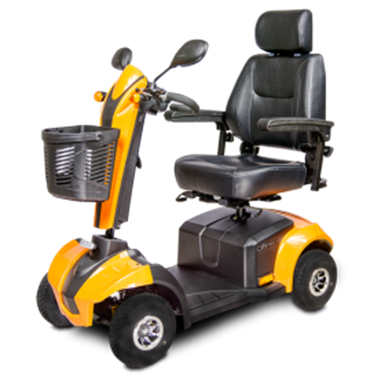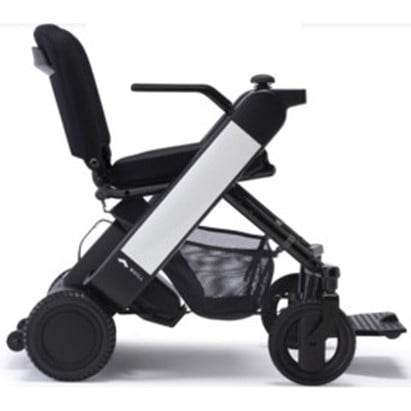For people that deal with or suffer from a lack of mobility when it comes to the solution, they do have two popular options to choose from, a power wheelchair and an electric scooter. When it comes to benefits like independence and accessibility they both have a lot to offer. However, most of the time people confuse them as being the same but it’s important to understand the differences between a power wheelchair and an electric scooter so it will be easier for you to select the most suitable option based on your needs.
Cura360 will explore and compare power wheelchairs and electric scooters highlighting their unique feature, advantages, and considerations. By the end of this blog, you’ll have a better and deeper understanding of which option may suit best your or your loved one’s mobility requirements.
So, let’s delve into the world of power wheelchairs and electric scooters and discover the factors to consider when making this important decision.

Pros and Cons of Electric Scooters
A list of pros and cons will help you easily understand if an electric scooter is best suitable for your needs or not. Firstly let’s take a look at the least of the pros.
- Maneuverability: Electric scooters are well known for their compact and lightweight design, making them highly maneuverable in crowded urban environments. They can easily navigate through tight spaces, such as sidewalks and shopping aisles, allowing users to move swiftly and efficiently.
- Portability: Electric scooters are typically designed to be foldable or disassembled, making them highly portable. They can be easily stored in a car trunk or taken on public transportation, enabling users to have mobility both indoors and outdoors.
- Speed and Range: Electric scooters can reach higher speeds compared to power wheelchairs, allowing users to cover longer distances in a shorter time. Many electric scooters also offer a respectable range per charge, making them suitable for commuting or leisurely rides.
- Ease of Use: Electric scooters are generally straightforward to operate. They often feature simple controls and intuitive steering, making them accessible to a wide range of users, including those with limited mobility or dexterity.
- Affordability: In general, electric scooters tend to be more affordable than power wheelchairs. This makes them a cost-effective option for individuals seeking personal mobility solutions.
Pros may influence your decision of buying an electric scooter but Cons will help you understand what exactly are you getting.
- Limited Seating Support: Unlike power wheelchairs, electric scooters typically offer limited seating support. They are designed for short term use, making them less suitable for individuals who require extended periods of seated comfort or additional postural support.
- Terrain Limitations: Electric scooters are best suited for smooth surfaces and well-maintained pathways. They may struggle to navigate rough or uneven terrain, limiting their usability in certain outdoor environments.
- Safety Concerns: Electric scooters can present safety concerns, especially if not used responsibly or in compliance with local regulations. Factors such as speed, stability, and user experience can affect safety, so it’s essential to use caution and follow applicable laws and guidelines.
- Weather Sensitivity: Electric scooters are generally not weather resistant, meaning they can be negatively affected by rain, snow, or extreme temperatures. This limits their usability during inclement weather conditions.
- Weight and Weight Capacity: While electric scooters are lightweight and portable, they may not be suitable for individuals with higher weight requirements. The weight capacity of electric scooters tends to be lower compared to power wheelchairs, which may limit their accessibility for certain users.

Pros and Cons of Power Wheelchair
A power wheelchair is another popular option for mobility so first let’s take a look at its pros.
- Enhanced Seating Support: Power wheelchairs typically offer more advanced seating systems and options for customization. They provide improved postural support and comfort, making them suitable for individuals who require extended periods of seated mobility.
- Versatility in Terrain: Power wheelchairs are designed to handle various terrains, including rough or uneven surfaces. They offer robust motors and suspension systems that allow users to navigate outdoor environments with greater ease and stability.
- Accessibility Features: Power wheelchairs often come equipped with additional accessibility features, such as seat elevation, tilt, or recline functions. These features provide users with better positioning options, pressure relief, and improved access to different environments and activities.
- User Friendly Controls: Power wheelchairs feature user friendly controls that are designed to accommodate individuals with different abilities. They offer options like joystick control, sip and puff systems, or head arrays, enabling users to operate the wheelchair easily and independently.
- Weight Capacity: Power wheelchairs typically have higher weight capacities compared to electric scooters. This makes them suitable for individuals with larger body sizes or higher weight requirements.
Let’s see now if the cons out weight the pros when it comes to power wheelchairs.
- Size and Bulkiness: Power wheelchairs are generally larger and bulkier compared to electric scooters. Their size may limit maneuverability in tight spaces and make transportation more challenging, particularly in smaller vehicles or crowded environments.
- Cost: Power wheelchairs tend to be more expensive than electric scooters due to their advanced features and customization options. The cost may pose a financial challenge for some individuals, especially if not covered by insurance or other funding sources.
- Maintenance and Repair: Power wheelchairs require regular maintenance and may occasionally require repairs. This can be time consuming and costly, particularly if specialized technicians or parts are needed.
- Dependence on Battery Power: Power wheelchairs rely on battery power, meaning they need to be charged regularly to ensure continuous use. Users need to consider battery life and plan for recharging to avoid unexpected interruptions in mobility.
- Learning Curve: Operating a power wheelchair may involve a learning curve, especially for individuals who are new to using mobility devices. Users need to become familiar with the controls, maneuvering techniques, and safety practices to ensure a smooth and safe experience.
It’s important to note that the pros and cons of power wheelchairs or electric scooters may vary based on the specific model chosen, personal requirements, and preferences. You can also explore Cura360’s best electric scooter and best power wheelchair blog to know about the best mobility aids available in the market.
Consult with healthcare professionals or contact our Cura360 mobility specialists and they can help individuals assess their needs and make an informed decision about whether a power wheelchair is the right choice for them.
How do mobility scooters and power wheelchairs operate
Electric scooters operate using a rechargeable battery as their power source. They typically have a control panel or handlebar with controls such as an on/off switch, throttle or accelerator, brakes, and additional features like lights and horns. By activating the throttle, the electric motor engages, propelling the scooter forward. Steering is achieved by turning the handlebars, allowing the front wheel(s) to change direction.
Power wheelchairs, on the other hand, are powered by rechargeable batteries as well. They feature a control panel or joystick within easy reach of the user. The joystick is the primary control for operating the wheelchair, with different movements controlling the wheelchair’s motorized wheels for forward, backward, left, and right motion. Power wheelchairs may also have additional functions controlled through the control panel or joysticks, such as seat elevation, tilt, or reclining, providing increased functionality and customization options for the user.
Conclusion:
The choice between a power wheelchair and an electric scooter ultimately depends on the specific needs and preferences of the individual user. Power wheelchairs are ideal for individuals who require enhanced seating support, advanced customization options, and versatility in navigating different terrains. They offer superior maneuverability, accessibility features, and a range of seating options, making them suitable for those who require extended periods of seated mobility and specialized postural support.
On the other hand, electric scooters are well suited for individuals who prioritize maneuverability in tight spaces, portability, and the ability to cover longer distances at higher speeds. They are compact, lightweight, and easily transportable, making them convenient for commuting or leisurely rides. Electric scooters are a suitable choice for individuals with good upper body strength and limited mobility needs.
So it’s important to understand your needs and preferences to finalize the best mobility aid for you. Visit Cura360 for useful product information and photos of both electric scooters and power wheelchairs. At Cura360, we are waiting to help you make the perfect decision regarding your mobility aid.
Send us a message in our chat box, and we will get back to you ASAP. You can also request a call back by clicking on the “call back” button or calling us at 1-833-207-3433.

 1-833-207-3433
1-833-207-3433
